Marsh D. Applied Geometry for Computer Graphics and CAD
Подождите немного. Документ загружается.


248 Applied Geometry for Computer Graphics and CAD
9.10. Determine a NURBS sphere by rotating the NURBS circle of Exam-
ple 8.21 about the z-axis. Apply a scaling of 3 units in the x-direction
and 2 units in the y-direction to the NURBS sphere to obtain an el-
lipsoid.
9.11. Determine a NURBS representation for a torus.
9.12. (a) Apply a scaling of a units in the x-direction and b units in the
y-direction to the NURBS circle to obtain an ellipse.
(b) Assume that the ellipse lies in the z = 0 plane (by adding a zero
third coordinate to the control points). Determine a NURBS
representation of an elliptic cylinder by (i) extruding the ellipse
through 1 unit in the direction of the z-axis, and (ii) translation-
ally sweeping the line segment (1 − t)(0, 0, 0) + t(0, 0, 1) along
the trajectory curve defined by the ellipse.
(c) Assume that the ellipse lies in the y = 0 plane (by adding a zero
second coordinate to the control points). Determine a NURBS
representation of an ellipsoid (of revolution) by rotating the el-
lipse about the z-axis.
9.13. Let a hyperbola be defined in NURBS form by control points
b
0
(−1, 0, 1), b
1
(0, 0, 0), b
2
(1, 0, 1), weights w
0
=1,w
1
=3,w
2
=1,
and knot vector −1, −1, −1, 1, 1, 1. Determine a NURBS representa-
tion of a hyperboloid (of one sheet) by rotating the hyperbola about
the z-axis.
9.14. Determine the ruled surface defined by the NURBS circle B(t)(as-
sumed to be in the z = 0 plane), and the quadratic NURBS curve
with control points b
0
(4, 0, 3), b
1
(4, 2, 3), b
2
(−4, 2, 3), b
3
(−4, 0, 3),
b
4
(−4, −6, 3), b
5
(4, −6, 3), b
6
(4, 0, 3), weights 1, 1, 1/2, 1, 1/2, 1, 1,
and knot vector 0, 0, 0, 1/4, 3/4, 1, 1, 1.
9.5 Surface Subdivision
The de Casteljau, de Boor, and knot insertion algorithms for integral and ra-
tional B´ezier and B-spline curves can be applied to surfaces. For instance, to
subdivide (or to evaluate the coordinates of a point of) a B´ezier surface S(s, t)
at the parameter value (s
0
,t
0
), the de Casteljau algorithm is applied first in the
t direction, and then again in the s direction, or vice versa. To apply the algo-
rithm in the t direction, each row of the control polyhedron (that is, the control
points p
i,j
with fixed i) is treated as the control polygon of a B´ezier curve in

9. Surfaces 249
the parameter t, and the de Casteljau algorithm is executed with t = t
0
.This
yields a subdivision of S(s, t)intotwoB´ezier subsurfaces along the parameter
curve S(s, t
0
). Similarly, the de Casteljau algorithm is executed with s = s
0
to
each column of the control polygon (that is, the control points p
i,j
with fixed
j). The result is that the surfaces are subdivided along the parameter curve
S(s
0
,t), giving a subdivision of the original surface into four surface patches.
The algorithm also yields an evaluation of the point S(s
0
,t
0
).
In a similar manner, the rational de Casteljau algorithm can be applied to
a rational B´ezier surface, and the de Boor and knot insertion algorithms can
be applied to a B-spline or NURBS surface. The following example elucidates
the method further.
Example 9.21
AB´ezier surface S(s, t) has control points
p
0,0
(2, 3, 0), p
0,1
(2, 6, 3), p
0,2
(2, 10, 0) ,
p
1,0
(6, 2, 1), p
1,1
(6, 6, 4), p
1,2
(6, 9, 1) ,
p
2,0
(10, 2, 0), p
2,1
(10, 6, 3), p
2,2
(10, 10, 0) .
Apply the de Casteljau algorithm to subdivide the surface along the coordinate
curves S(0.5,t)andS(s, 0.25), and to evaluate the point S(0.5, 0.25). Applying
the de Casteljau algorithm with t =0.25 to each row of control points yields
row i =0
(2, 3, 0) (2, 6, 3) (2, 10, 0)
(2.0, 3.75, 0.75) (2.0, 7.0, 2.25)
(2.0, 4.5625, 1.125)
row i =1
(6, 2, 1) (6, 6, 4) (6, 9, 1)
(6.0, 3.0, 1.75) (6.0, 6.75, 3.25)
(6.0, 3.9375, 2.125)
row i =2
(10, 2, 0) (10, 6, 3) (10, 10, 0)
(10.0, 3.0, 0.75) (10.0, 7.0, 2.25)
(10.0, 4.0, 1.125)
The result is two surfaces: the first with control points
p
0,0
(2, 3, 0), p
0,1
(2.0, 3.75, 0.75) , p
0,2
(2.0, 4.5625, 1.125) ,
p
1,0
(6, 2, 1), p
1,1
(6.0, 3.0, 1.75) , p
1,2
(6.0, 3.9375, 2.125) ,
p
2,0
(10, 2, 0), p
2,1
(10.0, 3.0, 0.75) , p
2,2
(10.0, 4.0, 1.125) ,
and the second surface with control points
p
0,0
(2.0, 4.5625, 1.125) , p
0,1
(2.0, 7.0, 2.25) , p
0,2
(2, 10, 0) ,
p
1,0
(6.0, 3.9375, 2.125) , p
1,1
(6.0, 6.75, 3.25) , p
1,2
(6, 9, 1) ,
p
2,0
(10.0, 4.0, 1.125) , p
2,1
(10.0, 7.0, 2.25) , p
2,2
(10, 10, 0) .
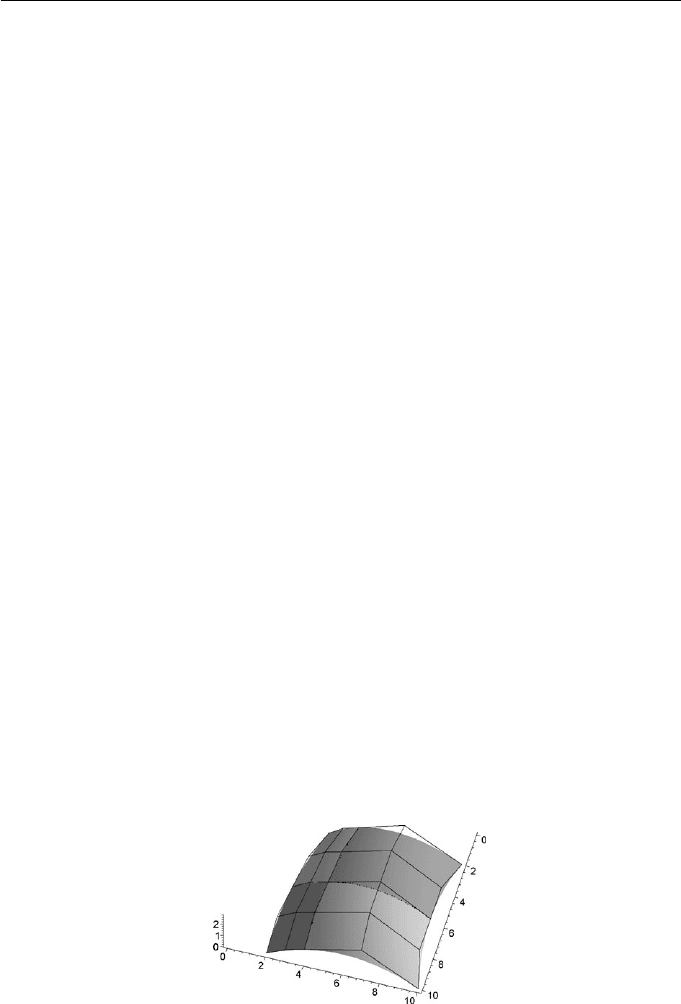
250 Applied Geometry for Computer Graphics and CAD
Next, apply the de Casteljau algorithm with s =0.5 to the first subsurface
(2, 3, 0) (6, 2, 1) (10, 2, 0)
(4, 2.5, 0.5) (8, 2, 0.5)
(6, 2.25, 0.5)
(2, 3.75, 0.75) (6, 3, 1.75) (10, 3, 0.75)
(4, 3.375, 1.25) (8, 3, 1.25)
(6, 3.1875, 1.25)
(2.0, 4.5625, 1.125) (6.0, 3.9375, 2.125) (10.0, 4.0, 1.125)
(4.0, 4.25, 1.625) (8.0, 3.96875, 1.625)
(6.0, 4.109375, 1.625)
and then to the second subsurface
(2.0, 4.5625, 1.125) (6.0, 3.9375, 2.125) (10.0, 4.0, 1.125)
(4.0, 4.25, 1.625) (8.0, 3.96875, 1.625)
(6.0, 4.109375, 1.625)
(2, 7, 2.25) (6.0, 6.75, 3.25) (10, 7, 2.25)
(4.0, 6.875, 2.75) (8.0, 6.875, 2.75)
(6.0, 6.875, 2.75)
(2, 10, 0) (6, 9, 1) (10, 10, 0)
(4.0, 9.5, 0.5) (8.0, 9.5, 0.5)
(6.0, 9.5, 0.5)
The last triangle of points of the first subsurface is identical to the first triangle
of the second subsurface since the subsurfaces have a common row of control
points. In practice the triangle would only be computed once, but it is included
here twice to illustrate that the surface is divided first into two and then into
four. As before the edges of the computed triangle give the control points
of the four surfaces resulting from the subdivision. The point S(0.5, 0.25) is
(6.0, 4.109375, 1.625). Note that only one of the t =0.25 subsurfaces needs to
be subdivided in order to evaluate this point. The subdivided surface is shown
in Figure 9.13.
Figure 9.13 Subdivided biquadratic B´ezier surface of Example 9.21
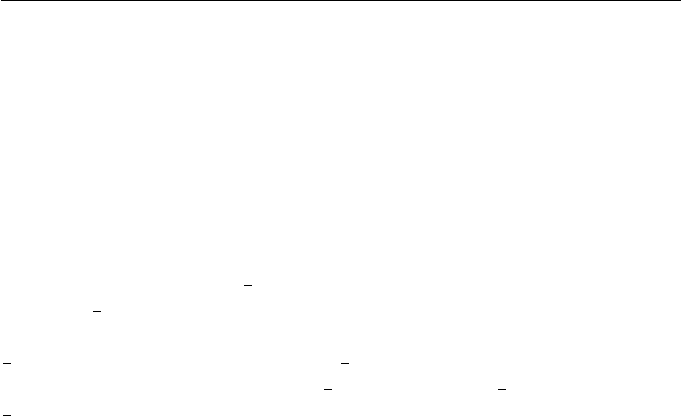
9. Surfaces 251
Subdivision of rational B´ezier, B-spline, and NURBS surfaces is performed by
applying the rational de Casteljau, the de Boor, or a knot insertion algorithm
in a similar manner.
Remark 9.22
The number of linear interpolations computed in a subdivision of a B´ezier
surface into four is easily determined. Suppose the surface has degree m in
the s direction and degree n in the t direction. The de Casteljau algorithm
in the s direction requires
1
2
m(m + 1) interpolations for each column giving
a total of
1
2
m(m +1)(n + 1) interpolations. The algorithm in the t direction
(remembering that there are now 2m +1 rows of n control points) requires
1
2
n(n+1) interpolations per row giving
1
2
(2m +1)n(n+1) interpolations in all.
The total number of interpolations is
1
2
m(m+1)(n +1)+
1
2
(2m +1)n(n+1) =
1
2
(n +1)
2mn + n + m
2
+ m
. Thus, depending on the degrees m and n,it
matters which direction is subdivided first. For instance, if m =3,n =4,then
the number of computations is 100. But if m =4,n = 3, then the number of
computations is 94. Thus it is most efficient to subdivide first in the variable
which has the largest degree.
EXERCISES
9.15. In Section 6.10.3, a method to determine the intersection of two
B´ezier curves using subdivision was described. Describe how the op-
eration of subdivision together with the convex hull property for
surfaces can be used to determine the curve of intersection of two
B´ezier surfaces.
9.16. Subdivide the B´ezier surface of Example 9.21 at s =0.25 and t =0.5.
9.17. Subdivide the B´ezier surface of Example 9.13 at s =0.4andt =0.2.
9.18. Use the de Boor algorithm to subdivide the B-spline surface of Ex-
ercise 9.3 at s =2.2andt =6.4.
9.6 Skin and Loft Surfaces
Skinning is the operation of constructing a surface that interpolates a number
of user specified curve sections. Clearly, there are an infinite number of surfaces
passing through two curves c(t)andd(t). One solution is to linearly interpolate
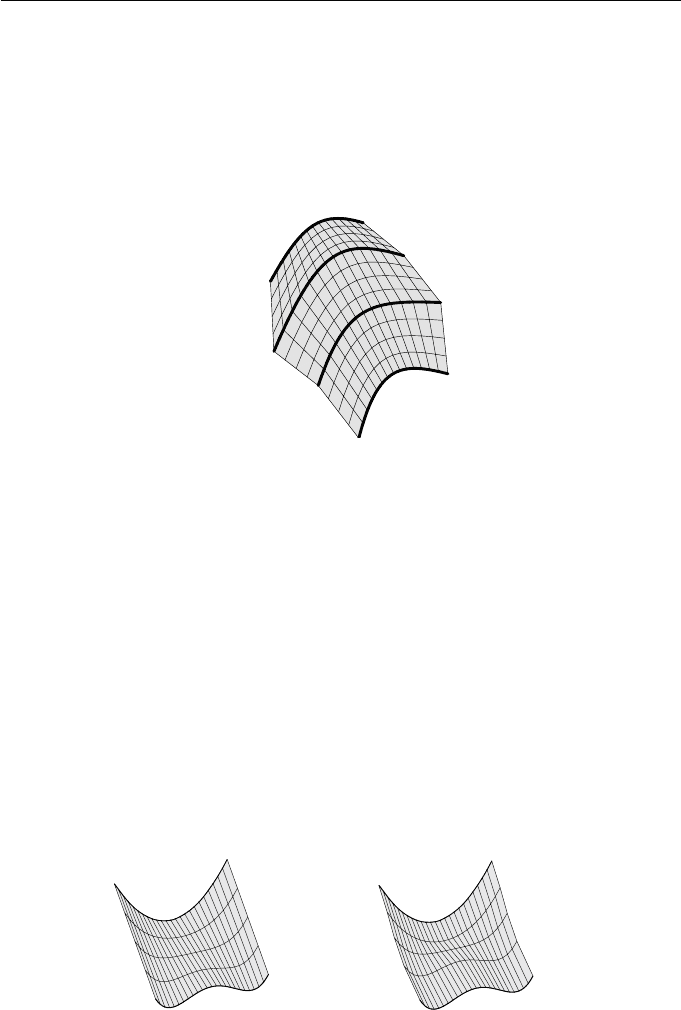
252 Applied Geometry for Computer Graphics and CAD
the two curves to give the ruled surface
x(s, t)=(1− s)c(t)+sd(t) . (9.15)
A sequence of curve sections can be skinned by computing ruled surfaces be-
tween adjacent pairs of curves as shown in Figure 9.14.
Figure 9.14 Skinning through curve sections
Example 9.23
Let two curve sections be c(t)=(t, t
2
, 0) and d(t)=(t, t
4
− t
2
, 10). Then the
skinning surface given by Equation (9.15) is
x(s, t)=
(1 − s)t + st, (1 − s)t
2
+ s(t
4
− t
2
), (1 − s)0 + s10
=(t, t
2
− 2st
2
+ st
4
, 10s) .
Figure 9.15(a) shows the skin surface and the intermediate parameter curves
corresponding to s =0.25, s =0.5ands =0.75.
d()t
c()t
s = 0.25
s = 0.5
s = 0.75
d()t
c()t
s = 0.25
s = 0.5
s = 0.75
(a) (b)
Figure 9.15 Skin and loft surfaces of Examples 9.23 and 9.25
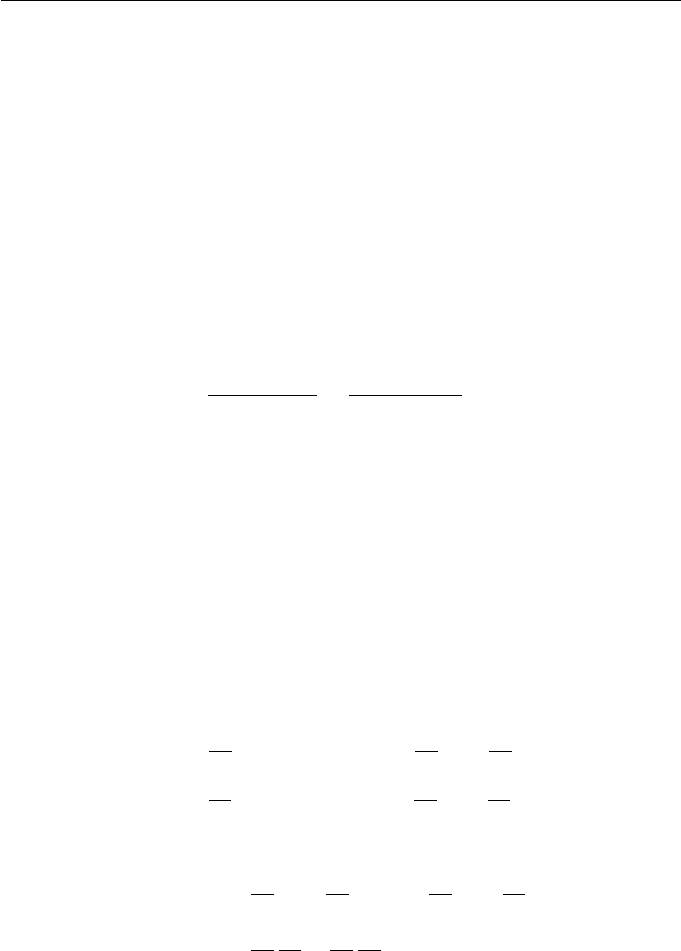
9. Surfaces 253
More general skinning surfaces can be achieved by replacing the blending func-
tions 1 −s and s in (9.15) by continuous functions f
0
(s)andf
1
(s) that satisfy
f
0
(0) = f
1
(1) = 1 and f
0
(1) = f
1
(0) = 0. Additionally, the blending functions
can be required to satisfy f
0
(s)+f
1
(s) = 1 in order to obtain skin surfaces that
are planar whenever the boundary curves are coplanar (Exercise 9.23).
To proceed further, it is necessary to introduce the notion of geometric
continuity for surfaces in a similar manner to curves in Definition 7.14.
Definition 9.24
Two regular surfaces x(s, t)andy(u, v) are said to meet with (parametric)
C
k
-continuity at a point P = x(s
0
,t
0
)=y(u
0
,v
0
) whenever
∂
i+j
x(s
0
,t
0
)
∂
i
s∂
j
t
=
∂
i+j
y(u
0
,v
0
)
∂
i
u∂
j
v
,
for 0 ≤ i + j ≤ k.
Two regular surfaces x(s, t)andy(u, v) are said to meet with G
k
-continuity
at a point P = x(s
0
,t
0
)=y(u
0
,v
0
) whenever there is an invertible mapping
(called a reparametrization ) h :(˜u, ˜v) → (u(˜u, ˜v),v(˜u, ˜v)) such that x(s, t)and
y(u(˜u, ˜v),v(˜u, ˜v)) meet with C
k
-continuity at P. Two surfaces are said to meet
with G
k
-continuity along a curve if they meet with G
k
-continuity at every point
of that curve.
Suppose that x(s, t)andy(u, v) meet with G
1
-continuity at P = x(s
0
,t
0
)=
y(u
0
,v
0
). Then there is a reparametrization u = u(˜u, ˜v), v = v(˜u, ˜v) for which
the chain rule gives
x
s
=
∂
∂˜u
y(u(˜u, ˜v),v(˜u, ˜v)) =
∂u
∂˜u
y
u
+
∂v
∂˜u
y
v
, (9.16)
x
t
=
∂
∂˜v
y(u(˜u, ˜v),v(˜u, ˜v)) =
∂u
∂˜v
y
u
+
∂v
∂˜v
y
v
. (9.17)
Hence
x
s
× x
t
=
∂u
∂˜u
y
u
+
∂v
∂˜u
y
v
×
∂u
∂˜v
y
u
+
∂v
∂˜v
y
v
=
∂u
∂˜u
∂v
∂˜v
−
∂v
∂˜u
∂u
∂˜v
(y
u
× y
v
) .
Therefore, when two surfaces meet with G
1
-continuity at a point P,theyhave
the same normal directions, and hence the same tangent planes. The converse is
also true: if two surfaces meet at a point P, and have common surface normals
at P, then the surfaces meet with G
1
-continuity (Exercise 9.22).

254 Applied Geometry for Computer Graphics and CAD
Skinning is often referred to as lofting, a term that arises from the ship-
building industry where some aspects of ship design took place in the lofts of
hangers. Some authors reserve the term “lofting” to mean a skinning operation
where the interpolating surfaces satisfy specified derivative conditions along the
curve sections. When a skinning operation is applied to a sequence of curve sec-
tions, the resulting surfaces meet (in general) with only C
0
-continuity. Lofting,
however, can yield surfaces that have G
1
-continuity along the curve sections.
Suppose two curve sections c(t)andd(t) and two derivative functions c
s
(t)
and d
s
(t) are specified. There is no unique loft surface but a commonly used
one is
x(s, t)=H
0
(s)c(t)+H
1
(s)d(t)+
ˆ
H
0
(s)c
s
(t)+
ˆ
H
1
(s)d
s
(t) , (9.18)
where H
i
(s)and
ˆ
H
i
(s) are the Hermite polynomials:
H
0
(s)=1− 3s
2
+2s
3
,
ˆ
H
0
(s)=s − 2s
2
+ s
3
,
H
1
(s)=3s
2
− 2s
3
,
ˆ
H
1
(s)=−s
2
+ s
3
.
Example 9.25
Let the curve sections be c(t)=(t, 0,t
2
)andd(t)=(t, 2,t
4
− t
2
), and the
derivative conditions be c
s
(t)=(0, 2, −1) and d
s
(t)=(0, 4, −0.5). (Note that
the derivative conditions can be non-constant.) Then the lofting surface given
by Equation (9.18) is
x(s, t)=(1− 3s
2
+2s
3
)(t, 0,t
2
)+(3s
2
− 2s
3
)(t, 2,t
4
− t
2
)
+(s − 2s
2
+ s
3
)(0, 2, −1) + (−s
2
+ s
3
)(0, 4, −0.5) .
The coordinate functions simplify to
x(t)=(1− 3s
2
+2s
3
)t +(3s
2
− 2s
3
)t = t,
y(t)=2(3s
2
− 2s
3
)+2(s − 2s
2
+ s
3
)+4(−s
2
+ s
3
)
=2s − 2s
2
+2s
3
,
z(t)=(1− 3s
2
+2s
3
)t
2
+(3s
2
− 2s
3
)(t
4
− t
2
)
− (s − 2s
2
+ s
3
) − 0.5(−s
2
+ s
3
)
= −s +2.5s
2
− 1.5s
3
+ t
2
− 6s
2
t
2
+4s
3
t
2
+3s
2
t
4
− 2s
3
t
4
.
The surface is shown in Figure 9.15(b).

9. Surfaces 255
More general lofting surfaces can be obtained by replacing the blending func-
tions H
0
, H
1
,
ˆ
H
0
and
ˆ
H
1
by functions f
0
(s), f
1
(s), g
0
(t), g
1
(t)thatsatisfy
f
0
(0) = f
1
(1) = 1 ,f
0
(1) = f
1
(0) = 0 ,
f
0
(0) = f
0
(1) = 0 ,f
1
(0) = f
1
(1) = 0 ,
g
0
(0) = g
0
(1) = 0 ,g
1
(0) = g
1
(1) = 0 ,
g
0
(0) = g
1
(1) = 1 ,g
0
(1) = g
1
(0) = 0 ,
to give the surface
x(s, t)=f
0
(s)c(t)+f
1
(s)d(t)+g
0
(s)c
s
(t)+g
1
(s)d
s
(t) . (9.19)
Next consider the task of constructing a surface through four boundary
curves: c(t), d(t), e(s)andf(s), as showed in Figure 9.16. Consider the skin
-10
0
10
20
30
x
0
10
20
30
y
-10
0
10
z
c()t
d()t
e( )t
f( )t
Figure 9.16 Gordon–Coons surface interpolating four boundary curves
surface x(s, t) that interpolates c(t)andd(t) given by (9.15). Substituting t =0
into (9.15) gives
x(s, 0) = (1 − s)c(0) + sd(0) .
Therefore, in order for x(s, t) to interpolate e(s)whent = 0 it is necessary to
modify (9.15) by adding
e(s) − (1 − s)c(0) − sd(0) .
Similarly, substituting t = 1 into (9.15) gives
x(s, 1) = (1 − s)c(1) + sd(1) ,
andinorderforx(s, t) to interpolate f(s)whent = 1 it is necessary to modify
(9.15) by adding
f(s) − (1 − s)c(1) − sd(1) .

256 Applied Geometry for Computer Graphics and CAD
The necessary correction across the entire surface is obtained by linearly inter-
polating the two correction terms
(1 − t)(e(s) − (1 − s)c(0) − sd(0)) + t (f(s) − (1 − s)c(1) − sd(1)) . (9.20)
Subtracting (9.20) from (9.15) yields the Gordon–Coons surface
ˆ
x(s, t)=(1− s)c(t)+sd(t)+(1− t)e(s)+tf(s)
− (1 − s)(1 − t)x
0,0
− (1 − s)tx
0,1
− s(1 − t)x
1,0
− stx
1,1
,
(9.21)
where
x
0,0
= c(0) = e(0) , x
0,1
= c(1) = f(0) ,
x
1,0
= d(0) = e(1) , x
1,1
= d(1) = f(1) .
The Gordon–Coons surface can be expressed in matrix form
x(s, t)=
1 − ss1
⎛
⎝
−x
0,0
−x
0,1
c(t)
−x
1,0
−x
1,1
d(t)
e(s) f(s) 0
⎞
⎠
⎛
⎝
1 − t
t
1
⎞
⎠
. (9.22)
The reader should verify that an identical formula is obtained if the above
method is applied to the interpolant of e(s)andf(s).
Example 9.26
Consider four boundary B´ezier curves that meet at vertices x
0,0
(−4, 0, −4),
x
0,1
(20, 0, 4), x
1,0
(−8, 20, 0) and x
1,1
(28, 30, 6) given by
c(t)=(−4, 0, −4)(1 − t)+(20, 0, 4)t,
d(t)=(−8, 20, 0)(1 − t)
2
+(10, 22, 16)2(1 − t)t +(28, 30, 6)t
2
,
e(s)=(−4, 0, −4)(1 − s)
2
+(−7, 12, −8)2(1 − s)s +(−8, 20, 0)s
2
,
f(s)=(20, 0, 4)(1 − s)
2
+(25, 12, 1)2(1 − s)s +(28, 30, 6)s
2
.
Using (9.21), the Gordon–Coons surface is x(s, t)=(x(s, t),y(s, t),z(s, t))
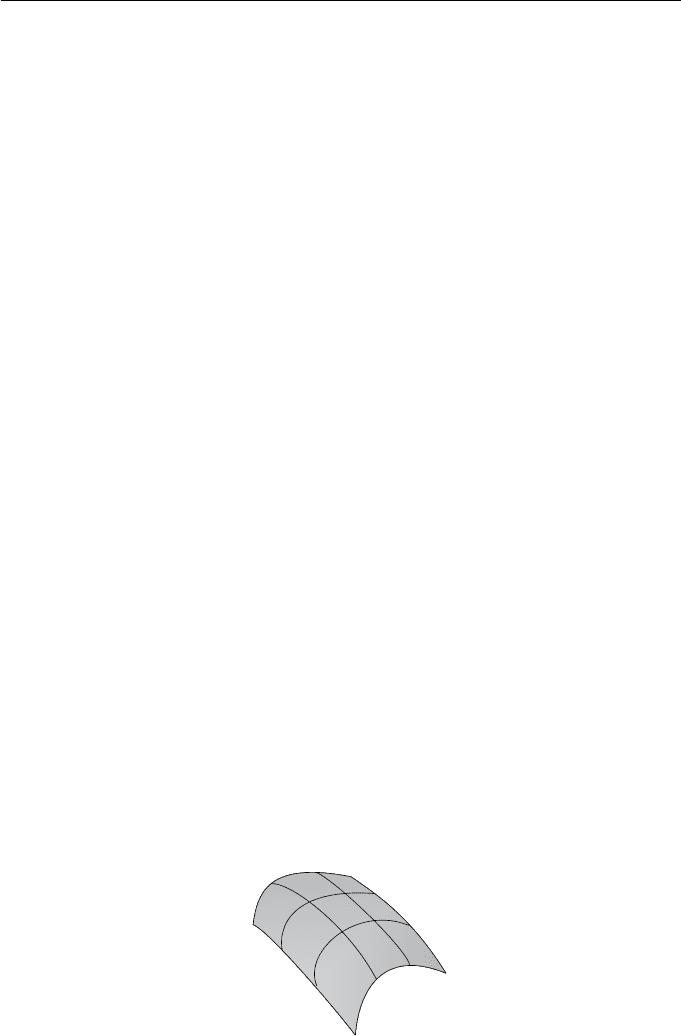
9. Surfaces 257
where
x(s, t)=4(1− s)(1− t) − 20 (1 − s) t +8s (1 − t) − 28 st
+(1− s)(−4+24t)+s
−8(1− t)
2
+20(1− t) t +28t
2
+(1− t)
−4(1− s)
2
− 14 (1 − s) s − 8 s
2
+ t
20 (1 − s)
2
+50(1− s) s +28s
2
= −4+24t − 6 s +16st +2s
2
− 4 ts
2
,
y(s, t)=−20 s (1 − t) − 30 st + s
20 (1 − t)
2
+44(1− t) t +30t
2
+(1− t)
24 (1 − s) s +20s
2
+ t
24 (1 − s) s +30s
2
=24s − 6 st +6st
2
− 4 s
2
+10ts
2
,
z(s, t)=4(1− s)(1− t) − 4(1− s) t − 6 st +(1− s)(−4+8t)
+ s
32 (1 − t) t +6t
2
+(1− t)
−4(1− s)
2
− 16 (1 − s) s
+ t
4(1− s)
2
+2(1− s) s +6s
2
= −4+8t − 8 s +28st − 26 st
2
+12s
2
− 4 ts
2
.
The surface is shown in Figure 9.16.
Given a grid or network of curves, as showed in Figure 9.17, Gordon–Coons
surfaces can be used to skin between each set of four boundary curve segments
to give a C
0
network surface. A general Gordon–Coons surface can be obtained
by replacing the blending functions 1 −s, s,1−t, t, that are used in (9.22), by
functions f
0
(s), f
1
(s), g
0
(t), g
1
(t)thatsatisfy
f
0
(0) = g
0
(0) = 1,f
0
(s)+f
1
(s)=1,
f
1
(1) = g
1
(1) = 0,g
0
(t)+g
1
(t)=1.
Figure 9.17 Network of curves interpolated by Gordon–Coons surfaces
